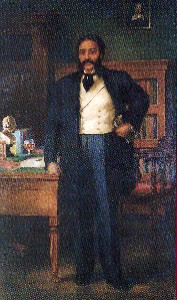
|
I like a man's knowledge to comprehend more than one class of topics, one row of shelves. . . . I like a man who likes to see a fine barn as well as a good tragedy. --Ralph Waldo Emerson (Journal, 1828) |
| |
| introduction |
| 1st canto |
| 2nd canto |
| 3rd canto |
| 4th canto |
| 5th canto |
| 6th canto |
| 7th canto |
| 8th canto |
| 9th canto |
| glossary |
The Slaying of Meghanada by Michael Madhusudan Datta "The poem is rising into splendid popularity. Some say it is better than Milton—that is all bosh—nothing can be better than Milton; many say it licks Kalidasa; I have no objection to that. I don't think it impossible to equal Virgil, Kalidasa, and Tasso." Michael Madhusudan Datta (1824-73 CE) wrote this in a letter to a friend about his verse narrative in nine cantos, The Slaying of Meghanada (1861). That epic, a Bangla version of the Ramayana story in which Ravana, not Rama, is the hero, has become a classic of Indian Literature. Michael lived in Bengal at the height of what is frequently called the Bengal Renaissance (also referred to as the Hindu Renaissance), a time so labeled for its reinvigoration and reconfiguration of the Hindu past and for the florescence of the literary arts. It was also a period when the Bengali city of Kolkata (then and until the present century known as Calcutta) was a center of world trade—the second city of the British empire—and thus a site for cultual exchange between India and the West. Datta was the perfect embodiment of this period and place. The Slaying of Meghanada shows influences from the Western epic tradition and is sprinkled with nods to Homer, Milton, and Dante. Datta's deft intermingling of Western and Eastern literary traditions brought about a sea change in South Asian literature and marks the dividing line between premodern and modern Bangla literature. The nine cantos—1st canto, 2nd canto, 3rd canto, 4th canto, 5th canto, 6th canto, 7th canto, 8th canto, 9th canto—come fronted here by an introduction. Datta revels in the names of gods, goddesses, and other strange and wonderful things from Hindu mythology. The many names in and of themselves can be somewhat overwhelming for those readers not fluently conversant with Hindu mythic lore. To make reading Datta's epic more meaningful and, I hope, enjoyable, a glossary is provided. The reader might want to keep that glossary file open while going through the epic itself, in order to be able to refer to it often and easily. |
| |
